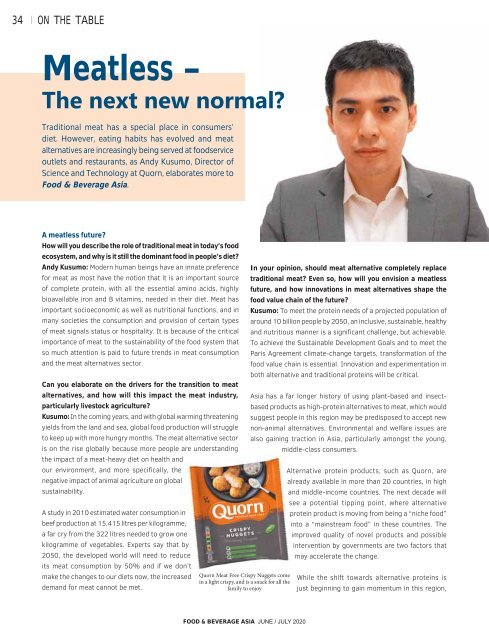Food & Beverage Asia June/July 2020
Food & Beverage Asia (FBA) is the leading source of food and beverage news in Asia since 2002. FBA delivers a comprehensive view of the food and beverage landscape, spanning across the latest health and nutrition trends and industry innovations in ingredients, recipe formulations, food science, sustainability, packaging, and automation, as well as advancements in agri and food-tech.
Food & Beverage Asia (FBA) is the leading source of food and beverage news in Asia since 2002. FBA delivers a comprehensive view of the food and beverage landscape, spanning across the latest health and nutrition trends and industry innovations in ingredients, recipe formulations, food science, sustainability, packaging, and automation, as well as advancements in agri and food-tech.
You also want an ePaper? Increase the reach of your titles
YUMPU automatically turns print PDFs into web optimized ePapers that Google loves.
34<br />
ON THE TABLE<br />
Meatless –<br />
The next new normal?<br />
Traditional meat has a special place in consumers’<br />
diet. However, eating habits has evolved and meat<br />
alternatives are increasingly being served at foodservice<br />
outlets and restaurants, as Andy Kusumo, Director of<br />
Science and Technology at Quorn, elaborates more to<br />
<strong>Food</strong> & <strong>Beverage</strong> <strong>Asia</strong>.<br />
A meatless future?<br />
How will you describe the role of traditional meat in today’s food<br />
ecosystem, and why is it still the dominant food in people’s diet?<br />
Andy Kusumo: Modern human beings have an innate preference<br />
for meat as most have the notion that it is an important source<br />
of complete protein, with all the essential amino acids, highly<br />
bioavailable iron and B vitamins, needed in their diet. Meat has<br />
important socioeconomic as well as nutritional functions, and in<br />
many societies the consumption and provision of certain types<br />
of meat signals status or hospitality. It is because of the critical<br />
importance of meat to the sustainability of the food system that<br />
so much attention is paid to future trends in meat consumption<br />
and the meat alternatives sector.<br />
Can you elaborate on the drivers for the transition to meat<br />
alternatives, and how will this impact the meat industry,<br />
particularly livestock agriculture?<br />
Kusumo: In the coming years, and with global warming threatening<br />
yields from the land and sea, global food production will struggle<br />
to keep up with more hungry months. The meat alternative sector<br />
is on the rise globally because more people are understanding<br />
the impact of a meat-heavy diet on health and<br />
our environment, and more specifically, the<br />
negative impact of animal agriculture on global<br />
sustainability.<br />
A study in 2010 estimated water consumption in<br />
beef production at 15,415 litres per kilogramme,<br />
a far cry from the 322 litres needed to grow one<br />
kilogramme of vegetables. Experts say that by<br />
2050, the developed world will need to reduce<br />
its meat consumption by 50% and if we don’t<br />
make the changes to our diets now, the increased<br />
demand for meat cannot be met.<br />
Quorn Meat Free Crispy Nuggets come<br />
in a light crispy, and is a snack for all the<br />
family to enjoy<br />
In your opinion, should meat alternative completely replace<br />
traditional meat? Even so, how will you envision a meatless<br />
future, and how innovations in meat alternatives shape the<br />
food value chain of the future?<br />
Kusumo: To meet the protein needs of a projected population of<br />
around 10 billion people by 2050, an inclusive, sustainable, healthy<br />
and nutritious manner is a significant challenge, but achievable.<br />
To achieve the Sustainable Development Goals and to meet the<br />
Paris Agreement climate-change targets, transformation of the<br />
food value chain is essential. Innovation and experimentation in<br />
both alternative and traditional proteins will be critical.<br />
<strong>Asia</strong> has a far longer history of using plant-based and insectbased<br />
products as high-protein alternatives to meat, which would<br />
suggest people in this region may be predisposed to accept new<br />
non-animal alternatives. Environmental and welfare issues are<br />
also gaining traction in <strong>Asia</strong>, particularly amongst the young,<br />
middle-class consumers.<br />
Alternative protein products, such as Quorn, are<br />
already available in more than 20 countries, in high<br />
and middle-income countries. The next decade will<br />
see a potential tipping point, where alternative<br />
protein product is moving from being a “niche food”<br />
into a “mainstream food” in these countries. The<br />
improved quality of novel products and possible<br />
intervention by governments are two factors that<br />
may accelerate the change.<br />
While the shift towards alternative proteins is<br />
just beginning to gain momentum in this region,<br />
FOOD & BEVERAGE ASIA JUNE / JULY <strong>2020</strong>



















